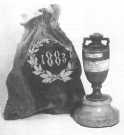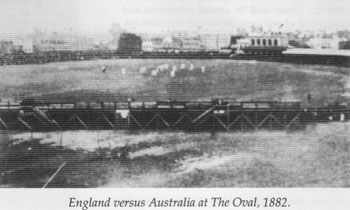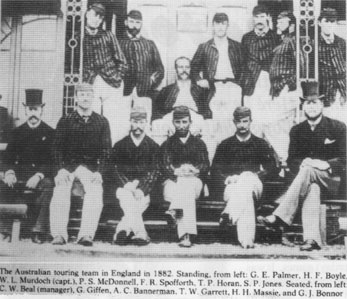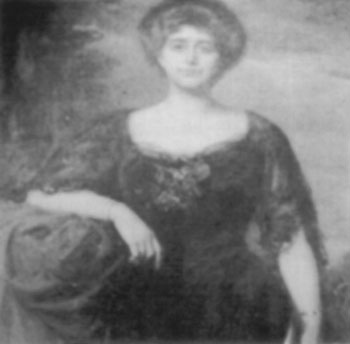 This coming summer
the Australians are once again on this side of the world where over the coming
months the "Ashes" will be contested between the tourists and their hosts in England.
Few words - if any - conjure up so much emotion and excitement in cricket as does
the term "The Ashes". Over the years there has been many a thrilling encounter
with both sides enduring many memorable occasions. What happened between the August
1882 Oval 'Test', which gave rise to the idea of 'ashes', and their emergence
as a reality on the other side of the world some six months later, has over the
years become shrouded in mystery. Many an explanation has added to a twist in
the tale rather than any unravelling of the matter on how the "Ashes" actually
came into being. What is somewhat forgotten is the Irish connection in the creation
of the Ashes.
This coming summer
the Australians are once again on this side of the world where over the coming
months the "Ashes" will be contested between the tourists and their hosts in England.
Few words - if any - conjure up so much emotion and excitement in cricket as does
the term "The Ashes". Over the years there has been many a thrilling encounter
with both sides enduring many memorable occasions. What happened between the August
1882 Oval 'Test', which gave rise to the idea of 'ashes', and their emergence
as a reality on the other side of the world some six months later, has over the
years become shrouded in mystery. Many an explanation has added to a twist in
the tale rather than any unravelling of the matter on how the "Ashes" actually
came into being. What is somewhat forgotten is the Irish connection in the creation
of the Ashes.
 The Oval "Test" in August 1882 ranks as among the most exciting of all down through the years. The encounter has been graphically described by many writers, most notably by H S Altham in A History of Cricket. This was indeed the second encounter in England between the sides, the first had also been played at the Oval some two years earlier with the hosts securing victory by five wickets. By the time the Australians under William Lloyd Murdoch arrived in Kennington in August 1882 they had played no less than twenty nine matches - eighteen of which had been won with a further eight drawn. Fred Spofforth - "The Demon" - took 14 English wickets for 90 and was largely responsible for the famous victory. After a dreadful start with the tourists all out for 63 runs in the first innings Murdoch's men recovered their composure to seal victory narrowly by some seven runs inside two days! The breathless tension of the final innings with Spofforth overwhelming the England batsmen is the sort of thing that leads to legends and none more so than this epic encounter. Tom Horan, who played for Australia in this Test and in all the four Tests against Ivo Bligh's 1882-83 tourists, was born in Midleton, County Cork, in March 1854.
The Oval "Test" in August 1882 ranks as among the most exciting of all down through the years. The encounter has been graphically described by many writers, most notably by H S Altham in A History of Cricket. This was indeed the second encounter in England between the sides, the first had also been played at the Oval some two years earlier with the hosts securing victory by five wickets. By the time the Australians under William Lloyd Murdoch arrived in Kennington in August 1882 they had played no less than twenty nine matches - eighteen of which had been won with a further eight drawn. Fred Spofforth - "The Demon" - took 14 English wickets for 90 and was largely responsible for the famous victory. After a dreadful start with the tourists all out for 63 runs in the first innings Murdoch's men recovered their composure to seal victory narrowly by some seven runs inside two days! The breathless tension of the final innings with Spofforth overwhelming the England batsmen is the sort of thing that leads to legends and none more so than this epic encounter. Tom Horan, who played for Australia in this Test and in all the four Tests against Ivo Bligh's 1882-83 tourists, was born in Midleton, County Cork, in March 1854.
Victory in England meant that Australia now offered the sternest challenge to the England national XI and of course even more important - their pride! As Punch recorded:
Well done, Cornstalks, whipt us
Fair and square.
Was it luck that tripped us?
Was it scare?
Kangaroo land's `Demon', or our own
Want of devil, coolness, nerve, backbone?
(Times do not appear to change as even with contemporary "failings" of Gower's and Gooch's England XIs receive similar consideration!) On the following Saturday, September 2nd, the Sporting Times carried the famous mock obituary for English cricket - an epitaph that lingers to this day and ensures posterity for the author.
In Affectionate Remembrance
of
E N G L I S H C R I C K E T,
which died at the Oval
on
29th A U G U S T, 1882,
Deeply lamented by a large circle of sorrowing friends and acquaintances
R.I.P.
N.B. - The body will be cremated and the ashes taken to Australia.
 Reginald Shirley Watkinshaw Brooks was the individual responsible for this "obituary". He was the eldest son of Shirley Brooks, a former Editor of Punch. Reginald's mother was one Emily Watkinshaw. She was in turn the daughter of one Dr William Bannatyre Watkinshaw of Naparima in Trinidad. Although a Creole Emily was - and proud of it - Irish. The tale goes that Emily was a brunette and her sister was blonde and in fashionable circles they were affectionately known as "Night and Morning".
Reginald Shirley Watkinshaw Brooks was the individual responsible for this "obituary". He was the eldest son of Shirley Brooks, a former Editor of Punch. Reginald's mother was one Emily Watkinshaw. She was in turn the daughter of one Dr William Bannatyre Watkinshaw of Naparima in Trinidad. Although a Creole Emily was - and proud of it - Irish. The tale goes that Emily was a brunette and her sister was blonde and in fashionable circles they were affectionately known as "Night and Morning".
It was left to the Honourable Ivo Bligh to retrieve honour the following Australian Summer. The first Test at Melbourne and the fourth at Sydney were lost but the Second and Third at Melbourne and Sydney respectively were won by Bligh's men and so honour was restored! The fourth Test at Sydney incidentally was not originally in the fixture list so the rubber went to Bligh's team. This match has subsequently been accorded Test status.
With Murdoch's Australians still playing cricket in England, Ivo Bligh's twelve strong party departed England for the southern hemisphere in mid September - a mere two weeks after the Oval defeat. The first game in Australia was against XV of South Australia in Adelaide in November. The two day game ended in a draw and in the South Australia capital Bligh made a speech in which he referred to the "Ashes". This mystified the locals somewhat as it meant little, if anything, to the local cricket fraternity - but the seed of the idea of the "Ashes" was spreading.
Victoria were the next opposition and at Melbourne Bligh's party stayed at Rupertwood - the country home in Sunbury of William Clarke. It was here that the Ashes itself became reality in the physical sense. According to one Pat Lyons who worked on the Clarke estate the Ashes came into factual presence during the Christmas sojourn of Bligh's party at Rupertswood. A game was played between the tourists and a number of others on the Clarke paddock. Unfortunately there remains some doubt as to whether the actual "Ashes" were the remains of the ball used in that game or the bails. Whichever, these ashes were presented to Bligh by the Ladies of the Household which included one Florence Morphy. The lives of Bligh and Florence Morphy would soon become further entwined through marriage.
Florence was the music teacher to the Clarke family and a companion to Sir William Clarke's wife, Lady Janet. Florence was the youngest daughter, born in August 1860, of Stephen Morphy. Stephen was the mining warden, district gold commissioner and police magistrate based at Beechworth, Victoria. He was Irish through and through, having come as an emigrant to Australia from Killarney. As to the Ashes urn itself there remains the two labels with inscription, the upper label simply bearing the legend The Ashes, the lower reads
When Ivo goes back with the urn, the urn;
Studds, Steel, Read and Tylecote return, return;
The welkin will ring loud,
The great crowd will feel proud,
Seeing Barlow and Bates with the urn, the urn;
And the rest coming home with the urn.
It is quite likely that these words were penned by Florence herself, although of course, this is in many ways a matter of conjecture.
In addition to the "Ashes" there is also the velvet bag which of course accompanies the "Ashes" urn in the Memorial Gallery at Lord's. This delightful item was the handiwork of one Mrs Ann Fletcher, nee Clarke. She was known as Annie and was the daughter of Joseph Hines Clarke and Marion Wright, both of Dublin. Joseph was with the Royal Irish Regiment and saw service in the Maori Wars. Ann married one John Fletcher and their eldest son, John William, played for Paddington, a team that also included among others the legendary Victor Trumper and Montagu Noble. John subsequently played for Queensland in 1909-1910.
The final game of the 1882-83 tour was against Victoria at Melbourne in March and in the post match banquet there was much talk of the "Ashes" by both Bligh and the Chairman of the Melbourne Cricket Club, F G Smith. The Ashes had arrived and were now a part of cricketing parlance. Shortly after this game Bligh sailed for England. Before he left Australia the Clarke's music teacher, Florence Morphy, had agreed to marry him. On February 7th, 1883, the Melbourne Punch bore the following poem:
ENGLAND V AUSTRALIA - ANOTHER "MATCH". The English Cricketers Over There and the Victorian Maiden Over Here. Air: Nelly Bligh (sic!)IVO BLIGH
Heaved a sigh,
When across the Main,
Said - "Unto Victoria's shores
I'll go back again".
Hi Ivo! Ho Ivo!
Cupid Take a Turn,
Puts to Ivo's heart his torch,
And "Ivo's ashes" burn.Ivo Bligh's Roguish eyes
Make a sudden "catch",
Sees a Southern Beauty here,
And seeks to play a "match".
Hi Ivo! Ho Ivo!
The Phoenix is the same,
From his "ashes" he will rise
To play the same old game.Ivo Bligh Means to try
A life of married bliss,
Let's hope that it will be a "hit",
Although he seeks to make a "miss",
Hi Ivo! Ho Ivo!
Happy may you be!
May bad luck never "run you out"
From your felicity.Ivo Bligh Need not cry
For cricket's ashes nore,
Since he takes his flame away
To burn on England's shore.
Hi Ivo! Ho Ivo!
This truth never doubt
A married man is best "at home",
And should be seldom "out".
 Bligh returned to Australia later in 1883 to marry Florence and on February 11th, 1884, the Argus reported the marriage of the "Honorable Ivo Francis Walter Bligh, second son of the Earl of Darnley ..." and "Miss Florence Rose Morphy, youngest daughter of the late John Stephen Morphy". In 1888 the married couple returned to England. Bligh's father, the 6th Earl Darnley, died in 1896 and the eldest son, Edward Bligh succeeded him as Earl. But Ivo became the eighth Earl Darnley in 1900 on the death of his brother, and settled in the family home of Cobham Hall which has long associations with the game of cricket. The Countess (right) quickly settled to her new role at Cobham Hall and promoted anything associated with arts and crafts. From October 1914 Cobham Hall was used as a military hospital, and this was to continue for five years. Over Christmas 1917 W M Hughes, the Australian Premier, was a guest and Florence spoke to the PM on behalf of a number of Australian airmen who sought to become the first to fly from England to Australia - Hughes gave his blessing. Two years later the flight was made with Captain Ross Smith and Lieutenant Keith Smith being accompanied in the Vickers Vimy Bomber by mechanics Sergeant J M Bennett and Sergeant W H Sheers. The Earl died in 1927 and two years later Dame Florence gave the Ashes to the MCC.
Bligh returned to Australia later in 1883 to marry Florence and on February 11th, 1884, the Argus reported the marriage of the "Honorable Ivo Francis Walter Bligh, second son of the Earl of Darnley ..." and "Miss Florence Rose Morphy, youngest daughter of the late John Stephen Morphy". In 1888 the married couple returned to England. Bligh's father, the 6th Earl Darnley, died in 1896 and the eldest son, Edward Bligh succeeded him as Earl. But Ivo became the eighth Earl Darnley in 1900 on the death of his brother, and settled in the family home of Cobham Hall which has long associations with the game of cricket. The Countess (right) quickly settled to her new role at Cobham Hall and promoted anything associated with arts and crafts. From October 1914 Cobham Hall was used as a military hospital, and this was to continue for five years. Over Christmas 1917 W M Hughes, the Australian Premier, was a guest and Florence spoke to the PM on behalf of a number of Australian airmen who sought to become the first to fly from England to Australia - Hughes gave his blessing. Two years later the flight was made with Captain Ross Smith and Lieutenant Keith Smith being accompanied in the Vickers Vimy Bomber by mechanics Sergeant J M Bennett and Sergeant W H Sheers. The Earl died in 1927 and two years later Dame Florence gave the Ashes to the MCC.
As a final word the term "Ashes" of course precedes these encounters between Australia and England and needless to say it is Ireland that bears the distinction in having the term coined. The Commissioners of the Lord Protector of England, Oliver Cromwell banned the playing of "Krickett" in Ireland by an order of 1656. All "sticks and balls" were henceforth to be burnt (and thereby reduced to ashes!) by the common hangman. So much for the l9th century Ashes - events in Ireland preceded these by over two hundred years.
